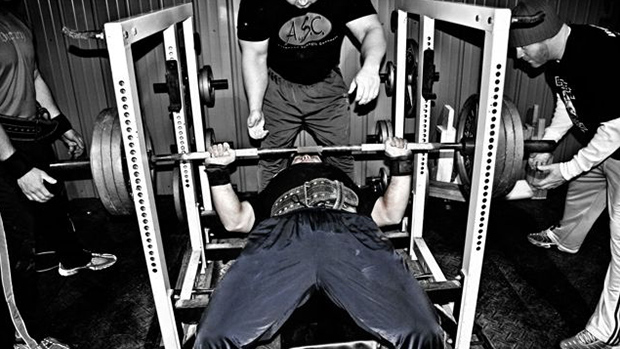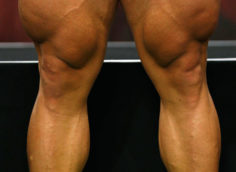You know the story: Prisoners work out every day, often without much in the way of equipment, and get jacked.
How do they do it? Don't they know the "rules" about not training the same muscle every day? They know next to nothing about physiology, have limited choices when it comes to diet, and many of them are in better shape than you. Ouch, not fair!
So what's going on here? Well, I recently stumbled upon a type of training that may help us answer that question. It's probably one of the simplest ways to add muscle mass to the chest, upper back, shoulders, arms, and upper legs. And when you do this type of training correctly, you'll stay lean without changing your diet.
And get this: it's just a supplemental workout. Something you can easily add to your current training program in just a few minutes each day.
First, allow me to tell you how I came across this workout. Then I have a little challenge for you.
How It Began
Last year Robert hired me to help him get strong and fix his aching joints. He'd just turned 40 and was in decent shape, but he needed some professional help to take him to the next level. So I designed a program to boost his relative strength and help his joints.
After four weeks he saw excellent improvements in his strength, muscle, and mobility. He could move better and faster, and he felt stronger.
After looking over the next phase of his program he asked if he could add push-ups throughout the day. Normally, I allow clients to do additional push-ups whenever and wherever because it usually doesn't hurt anything. But Robert had a pretty messed-up shoulder when he started working with me. He showed marked improvement though, so I told him to go for it. But I had to ask, "Why do you want to do push-ups throughout the day?"
"The more push-ups I do, the leaner I get," he responded.
At this point about a million thoughts ran through my mind. First, he didn't mention anything before about wanting to get leaner, so I had him on maintenance-level calories.
Second, I was very reluctant to believe that adding push-ups would make any real difference in fat loss, even though I know how effective high frequency training (HFT) parameters are for body transformation.
Third, I realized that if he was right, this would be the perfect time to test the hypothesis since he wasn't following a diet for fat loss.
So I gave him the green light to do push-ups whenever he wanted over the next four weeks. When he met with me at the end of the phase, sure enough, his waist had decreased almost an inch... without dieting.
Turns out he was doing about 100 push-ups per day, on top of our training sessions, but sure enough his shoulder had started acting up again. Some soft tissue work fixed that, but I had to admit: the rest of his plan worked. The push-ups leaned him out and his chest measurement increased by about an inch in four weeks.

A Better Approach
For his third, month-long phase, I asked what his goals were. He said he wanted to start adding muscle to his frame while continuing to lean out. He, of course, wanted to keep doing 100 push-ups every day.
I reminded him of the unpleasant soft tissue treatment I had to put him through after his push-up blitzkrieg. However, I had a plan.
I designed a supplemental workout that he could do every day – a HFT workout that would help him get leaner and add muscle without throwing his joints out of balance. We added the workouts to the full-body relative strength and mobility program I had him on.
This was his "extra" workout for the first day of his 30-day program.
- Pull-up: 10 reps
- Reverse lunge with no additional weight: 10 reps with each leg
- Push-up: 10 reps
Of course, he thought it was way too easy. That's when I dropped the bomb on him. I said, "That's what you'll do for day one. The next day you'll do 11 reps of each. The third day you'll do 12 reps of each. By the end of April (day 30) you'll do 39 reps of each exercise."
The pull-up, lunge, push-up (PLP) program was born.
Robert's Results
Before my client started the PLP program in April of last year, I took his measurements. Afterward, I measured again. Here were his results:
Chest (across nipple line): Gain of one inch
He gained a full inch on his chest, in spite of the fact that he did significantly fewer push-ups than he did the month before. A good portion of the enhanced chest measurement girth came from the muscle he added to his upper back with all the extra pull-ups.
Arms: Gain of about half an inch on each arm
This was no surprise considering how effective the pull-up is for adding mass to the elbow flexors. From an intensity standpoint, the pull-up is the most demanding of the three exercises. That's why he achieved the highest proportional gains with this exercise.
Upper legs: Gain of half inch to each thigh
The thigh musculature responds better than just about any muscle group to a wide range of reps and intensity. Cyclists have huge thighs, and so do Olympic lifters. Even though the load (his body weight) was light, the volume was sufficient to induce hypertrophy.
Waist (across navel): Loss of 1 1/8 inch
Of all the results, an inch-plus drop in his waist measurement surprised me most. The additional workouts were excellent for fat loss. It also explained why his body weight was relatively unchanged at the end of the month, even though he gained muscle. Indeed, he replaced fat with muscle.
What You Can Expect
There are a few things to keep in mind when you consider Robert's results.
First, he was on a relative strength program (low volume, high load) with maintenance calories. In other words, his main program wasn't intended to add muscle mass since that requires higher volume work and more calories. Yet he gained muscle and lost fat.
Second, after one month on the PLP program his shoulders were healthier than when he started. Remember, when he did tons of extra push-ups the month before, it disrupted his shoulder joint health. So, it is possible to add a considerable amount of extra work and keep your joints intact ifthe balance between pushing and pulling is right, and if you're doing exercises in your main workout to support joint health (face pulls, external rotations, and trap raises).
Third, there's not a lot of data on this method. But since April I've had four other clients add the PLP plan to their program. Each client had different goals in their main program (hypertrophy or fat loss or relative strength). However, everyone has achieved results similar to Robert's. Importantly, it appears that the longer you stay on the program, the better it works.
After testing my clients, these are the benefits you can expect from adding PLP to your current plan.
- More muscle as determined by enhanced girth of your chest, upper arm, and upper leg measurements.
- Greater fat loss as determined by a drop in waist girth.
- Enhanced muscle recovery. (Think of the PLP program as GPP work or active recovery.)
- Greater endurance. It's a no brainer that this program will add significant reps to the pull-up, push-up, and body-weight lunge. But the PLP program has also helped my athletes increase their time to exhaustion in exercises like the sled push that challenge anaerobic endurance. It also boosts their aerobic endurance, which makes sense because Tabata taught us long ago that higher intensity work will benefit the aerobic systems.

The Challenge
Are you up for a 60-day challenge to build a leaner, more muscular body? If so, here are the details.
1. If you can perform more than 10 continuous pull-ups.
Start with 10 reps of the pull-up, 10 reps of the lunge (each leg), and 10 reps of the push-up on the first day. Keep adding one rep to each exercise each day until you reach 69 reps on day 60. If you can only knock off a single-digit set of body-weight pull-ups, start with one rep of each exercise on the first day and add a rep to each exercise each day. So on day 60 you'll be doing 60 reps of each exercise.
2. Spread out the reps as much as needed.
As you get into higher reps you won't be able to finish all of them in one set. This is how it's supposed to be. You can spread the reps throughout the day. Most of my clients start their day with a circuit of the PLP program before breakfast. For example, on day 32 of this program my client did four rounds of eight reps with each exercise. It took him five minutes to complete. Later in the day, do your main workout. Generally, try to have at least 6 hours between the PLP workout and your main workout. And you don't need pre/post-workout nutrition for PLP workouts. Save that for your main workouts.
3. Don't do more.
T Nation readers are a motivated bunch, and many will want to do more reps at first. Don't. The first week should feel like nothing. It's important to slowly build the volume so your ability to recover isn't overwhelmed. The PLP program, or any HFT program, is intended to work a lot like compounding interest: small additions each day make a big difference over the long haul. If you start with 10 reps of each exercise on the first day, by the end of the first 30 days you'll have performed 735 reps of the pull-up, lunge (with each leg), and push-up. The volume really adds up between days 31-60. During that time you'll perform an additional 1,635 reps!
4. Use different movement variations.
You can use different versions of each exercise. For example, feel free to do pull-ups with a narrow or wide pronated hand position, a narrow or wide neutral hand position (palms facing each other), or a supinated (palms facing you) grip. Push-ups can be performed with your hands wide, narrow, or in between. Lunges can be forward, reverse, or to the side. There's no set rule, but my clients usually rotate between two and three different hand positions every few days. Do whichever version you feel like doing that day.
5. Don't change your main program.
Regardless of what program you're on, keep it as is. The PLP program is a supplement to what you're currently doing.
Ready to Try It?
Even though the daily volume is low, this will seem like a hellacious amount of total volume. But you'll be amazed how little soreness you feel once you get a few weeks into the program. That's because the PLP program supercharges your recovery ability, and that's essential for faster muscle growth.
Take measurements and/or pictures and get started. I'll be posting in the LiveSpill on a regular basis to offer tips and guidance.
Start today!
PLP Summary
I Can Do More Than 10 Pull-Ups
- Pull-up: (any hand position) for 10 reps
- Lunge: (any version) for 10 reps with each leg
- Push-up: (any hand position) for 10 reps
- Progression:: Add one rep to each exercise every day for 60 days. This results in 2370 reps of each exercise over the course of 60 days.
I Can Do Less Than 10 Pull-Ups
- Pull-up: (any hand position) for 1 rep
- Lunge: (any version) for 1 rep with each leg
- Push-up: (any hand position) for 1 rep
- Progression:: Add one rep to each exercise every day for 60 days. This results in 1830 reps of each exercise over the course of 60 days.





